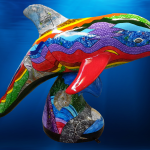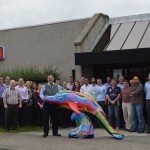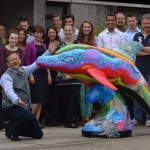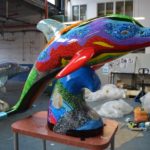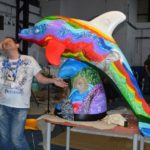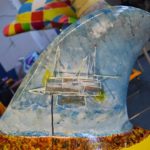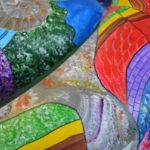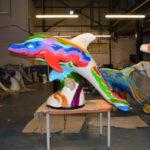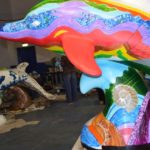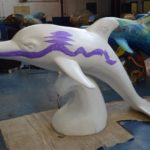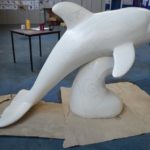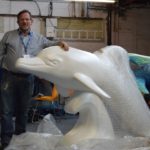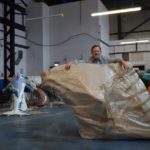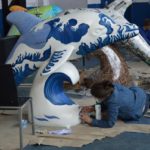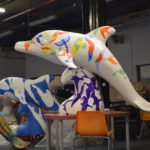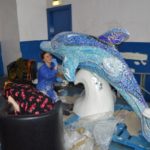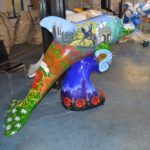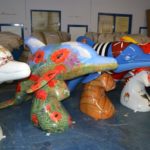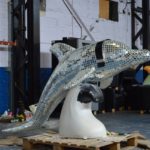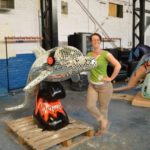Wild Dolphins - Rocky the Dolphin
The Wild Dolphins project saw Aberdeen come to life in the summer of 2014 with life size dolphin sculptures 'leaping off' the streets; each one individually painted by local artists. The sculptures formed a trail around the city, inviting residents to become 'tourists' in their own city. My contribution was Rocky.
At the end of the exhibition, the sculptures were auctioned and raised an incredible £531,000 for the ARCHIE Foundation, the offical charity of the Royal Aberdeen Children's Hospital Whale and Dolphin Conservation.
My contribution to this wonderful event was to be sponsored by HRH Geology to paint 'Rocky', the dolphin about rocks. Rocky celebrates how geological knowledge can help with our understanding of our sentient cousins. It also celebrates Aberdeen's history of exploration below the home of the dolphin. The colours on the main body of the dolphin are based on the International Commission on Stratigraphy.
The narrative starts with the dorsal fin which depicts an oil platform sitting in the home of the dolphins, the North Sea. The yellow and orange, flat lying beds represent the Cenozoic. This period is rich in true dolphin fossil remains. There are no modern dolphin remains before this time (the exact time that dolphins appear is the upper Eocene.)
The next section is marked with a wiggly line, that represents a break in deposition of sediments. Below the wiggly line (or unconformity in geological terms) comes the Mesozoic. Green, blue and purple layers here represent the ages in which 'dolphin like' creatures called Ichthyosaur lived. (working backwards.. Cretaceous - Green, Jurrasic - Blue, Triassic - Purple). The purple layers are the oldest rocks these animals can be found in.
The red coloured rocks are of the of the Permian, late Paleozoic.
The shapes of the painting represent different structures
At the end of the exhibition, the sculptures were auctioned and raised an incredible £531,000 for the ARCHIE Foundation, the offical charity of the Royal Aberdeen Children's Hospital Whale and Dolphin Conservation.
Rocky alone raised £17,000 at auction.
My contribution to this wonderful event was to be sponsored by HRH Geology to paint 'Rocky', the dolphin about rocks. Rocky celebrates how geological knowledge can help with our understanding of our sentient cousins. It also celebrates Aberdeen's history of exploration below the home of the dolphin. The colours on the main body of the dolphin are based on the International Commission on Stratigraphy.
The narrative starts with the dorsal fin which depicts an oil platform sitting in the home of the dolphins, the North Sea. The yellow and orange, flat lying beds represent the Cenozoic. This period is rich in true dolphin fossil remains. There are no modern dolphin remains before this time (the exact time that dolphins appear is the upper Eocene.)
The next section is marked with a wiggly line, that represents a break in deposition of sediments. Below the wiggly line (or unconformity in geological terms) comes the Mesozoic. Green, blue and purple layers here represent the ages in which 'dolphin like' creatures called Ichthyosaur lived. (working backwards.. Cretaceous - Green, Jurrasic - Blue, Triassic - Purple). The purple layers are the oldest rocks these animals can be found in.
The red coloured rocks are of the of the Permian, late Paleozoic.
The shapes of the painting represent different structures that the rocks make below ground level and the plinth contains sendiments containing fossils that help us date the rocks and also the black, white and grey represent the Aberdeen Granite.
A geological joke in the base, for up and coming geologists, is that there are fossils in the granite.. something that never happens in these particular rocks.

